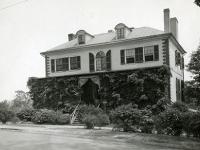Answer: Samuel Breck
Sweetbriar Mansion was built in 1797 by Samuel Breck as a place for his family to escape the yellow fever epidemic that was killing thousands of Philadelphians. John Ross, Breck’s father-in-law, bought the property, originally called “Peterstone,” in 1791. Breck later acquired the land and built Sweetbriar Mansion; its name came from all of the roses that grew there.
Breck was a merchant by trade, but was also active in politics and philanthropy. During the early 1800s he served in the Pennsylvania State House of Representatives, as a Federalist in the U.S. Congress, and a member of the Pennsylvania State Senate. He was acquainted with many of the prominent men of his day, including the Marquis de Lafayette, Daniel Webster, and Nicholas Biddle.
Although the family was able to escape yellow fever, Breck and his wife Jean’s only daughter Lucy died of Typhus, also known as “River Fever” at the age of 21. Not long after the loss of their daughter, the Brecks sold the property and in 1869 Sweetbriar became part of Fairmount Park. Since the mid-20th century, the Modern Club of Philadelphia, Inc., a philanthropic organization that works in cooperation with the Fairmount Park Commission, has overseen its care and maintenance. The club offers tours of the property by appointment.
The Samuel Breck papers (#1887) at HSP contains diaries, travel logs, manuscripts, lecture transcripts, notes, and graphics that illustrate Breck's many interests and represent a near-lifetime’s worth of documentation. In his papers, researchers will find that Breck devoted the bulk of his attention to American and European history and politics, philanthropy, and literature.
Image: Sweetbriar Mansion, photograph by Philip B. Wallace (1917)

